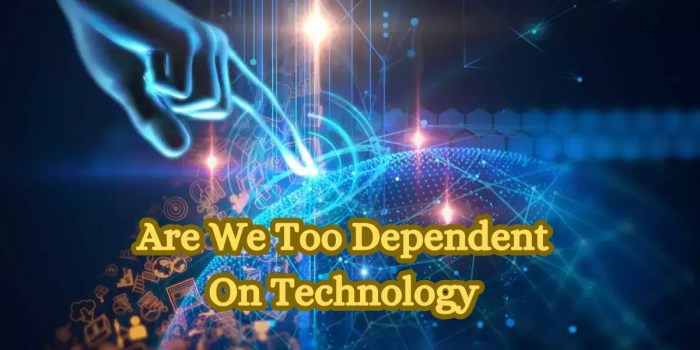Has technology made lazy and dependent – Has technology made us lazy and dependent? This question probes the complex relationship between human behavior and technological advancement. We’ll explore how our interpretations of “lazy” and “dependent” have evolved alongside technology, examining its impact on motivation, productivity, social interaction, employment, cognitive abilities, and individual agency.
From the rise of automation to the ubiquitous nature of social media, technology has reshaped our lives in countless ways. This exploration delves into the nuances of this transformation, considering both the potential downsides of dependence and the innovative possibilities for growth and connection.
Defining “Lazy” and “Dependent” in the Technological Context
The relentless march of technology has reshaped our lives, introducing new ways of working, interacting, and even thinking. Consequently, concepts like “laziness” and “dependence” have taken on nuanced meanings in this technologically advanced era. These terms are no longer straightforward judgments; their interpretations are deeply intertwined with the specific technological context, cultural backgrounds, and generational perspectives. This exploration delves into the evolving definitions of these concepts in our interconnected world.Defining “laziness” and “dependence” within the technological landscape is far from simple.
In the past, these terms often implied a lack of effort or self-reliance, but now they are frequently intertwined with the ease and accessibility technology provides. A generation accustomed to instant gratification might perceive the effort required for manual tasks as “lazy” compared to using readily available technological solutions. Similarly, a reliance on digital tools for information gathering or communication can be viewed as “dependence” by those raised in an era of less readily available information.
Interpretations of “Lazy” and “Dependent”
Different generations and cultures have varying perspectives on what constitutes “lazy” and “dependent” behavior. A younger generation, more familiar with the immediacy and efficiency of technology, might view seeking help online or using a digital assistant as perfectly normal, whereas an older generation might see these actions as signs of laziness or dependence. Cultural norms also play a crucial role.
In some cultures, collaboration and seeking assistance are highly valued, whereas in others, self-reliance and independent action are prioritized. These variations highlight the subjective nature of these judgments.
Examples of Technological “Laziness” and “Dependence”
Technological advancements have spawned new forms of “laziness” and “dependence.” An individual who relies on GPS for every journey, neglecting the development of their own sense of direction, might be considered technologically dependent. Similarly, someone who readily uses online research tools to complete tasks, without engaging in independent thought, might be perceived as technologically lazy. These behaviors, however, are not inherently negative; they simply represent different approaches to problem-solving and information acquisition in a technologically driven society.
Historical Context Comparison
These modern interpretations of “laziness” and “dependence” can be contrasted with historical precedents. In previous eras of societal change, similar judgments were made about new technologies. For example, the introduction of the printing press was met with anxieties about the potential for intellectual laziness and the dependence on printed information. The historical context of such concerns offers valuable insight into how similar anxieties are present in our own time.
Comparison Table: Pre-Technological vs. Technological Eras
| Characteristic | Pre-Technological Era | Technological Era |
|---|---|---|
| Laziness | Lack of effort, unwillingness to work | Over-reliance on technology for tasks, neglecting self-reliance |
| Dependence | Reliance on others for basic necessities | Reliance on technology for information, communication, and tasks |
| Examples of Laziness | Refusal to perform manual labor | Skipping research and relying solely on online summaries |
| Examples of Dependence | Total dependence on family or community for survival | Reliance on social media for validation or opinions |
Technology’s Impact on Motivation and Productivity
Technology has irrevocably altered the landscape of work, impacting everything from how we access information to how we complete tasks. This shift has profoundly affected motivation and productivity, creating both opportunities and challenges. The ease of access to information and tools has simultaneously empowered and potentially hindered our ability to focus and maintain a strong work ethic.The availability of readily accessible information and sophisticated tools has undeniably streamlined numerous processes.
However, this streamlining can also create a dependency, potentially diminishing the need for manual effort and the development of critical thinking skills. Examining the impact on motivation and productivity requires a nuanced understanding of the interplay between technology and human behavior. This exploration will delve into the multifaceted effects of technology on work habits across various industries.
Impact on Motivation and Work Ethic
Access to information and tools has profoundly altered work habits across numerous sectors. The immediate gratification offered by technology, coupled with the constant flow of new information, can potentially diminish sustained focus and motivation. Workers may become accustomed to instant results and quick fixes, potentially impacting their ability to persevere through more challenging tasks requiring sustained effort and meticulous planning.
Streamlining Processes and Efficiency
Technology has revolutionized various industries, significantly impacting work processes. Automation and streamlined workflows have increased efficiency in many sectors. The ability to perform complex calculations, manage data, and communicate instantly has improved output and reduced the time required for many tasks. This efficiency has led to an increase in productivity in certain sectors, allowing workers to focus on higher-level tasks and creative problem-solving.
Comparison of Work Habits Before and After Technological Advancements
The advent of computers and the internet has dramatically changed how individuals work. In the past, manual labor and repetitive tasks were the norm. Today, automation and software solutions have taken over many of these processes, allowing workers to concentrate on tasks requiring more complex skills and judgment. For example, in manufacturing, robots and automated assembly lines have replaced human workers for repetitive tasks, while human workers are now responsible for monitoring and maintenance of these machines.
In the service industry, online ordering and customer support platforms have streamlined interactions.
Examples of Technology Fostering Creativity and Productivity
Technology doesn’t inherently lead to laziness; instead, it can be a powerful tool for enhancing creativity and productivity. Software tools, such as graphic design programs and video editing applications, enable individuals to bring creative ideas to life. Project management software fosters collaboration and task organization, helping teams achieve their goals efficiently. Online research tools enable quick access to information, enabling workers to quickly solve problems and explore new avenues for innovation.
Pros and Cons of Technology on Work Ethic in Different Professional Fields
| Professional Field | Pros | Cons |
|---|---|---|
| Manufacturing | Increased efficiency through automation, reduced errors in repetitive tasks, improved safety measures. | Potential job displacement, need for retraining, dependence on complex machinery. |
| Customer Service | Improved response time, wider reach through online channels, increased accessibility. | Potential for impersonal interactions, increased workload due to 24/7 availability, dependence on technology for customer communication. |
| Education | Enhanced learning experience through online resources, personalized learning opportunities, increased accessibility. | Potential for distraction, dependence on technology for learning, difficulty in maintaining focus and discipline. |
| Healthcare | Advanced diagnostic tools, remote patient monitoring, improved communication between medical professionals. | Over-reliance on technology for diagnoses, potential for errors in data interpretation, ethical concerns regarding data privacy. |
The Role of Technology in Social Interaction and Relationships
Technology has profoundly reshaped the landscape of human connection. From instant messaging to social media platforms, digital tools have become integral components of our social lives, impacting how we interact, build relationships, and navigate the complexities of human connection. This shift necessitates a careful examination of both the positive and negative consequences of this technological evolution on our social fabric.Technology has fundamentally altered the dynamics of social interaction, blurring geographical boundaries and creating unprecedented opportunities for connection.
However, this connectivity has also introduced new challenges and potential pitfalls.
Altered Social Interaction Patterns
The rise of social media and communication platforms has revolutionized how we interact. Real-time communication tools like instant messaging and video conferencing have enabled instant global communication, fostering connections across vast distances. This has allowed individuals to maintain relationships with family and friends who live far away, fostering a sense of closeness and shared experiences. However, this shift has also led to a decline in face-to-face interactions, sometimes resulting in superficial connections and a diminished capacity for nuanced interpersonal communication.
While technology might seem to have made us more reliant on instant solutions, it’s not necessarily making us lazy. Think about how crucial tools like well-researched travel guides can be to effectively prevent jet lag. Following the 7 easy steps detailed in this helpful guide effectively prevent jet lag 7 easy steps can make a huge difference in your travel experience.
Ultimately, technology’s impact on laziness depends on how we choose to use it. It’s not about the tool, but about the user’s attitude and approach.
Increased Social Isolation or Dependence on Technology
The ease of online connection can ironically contribute to feelings of isolation. Excessive reliance on technology for social interaction can hinder the development of crucial interpersonal skills and the ability to navigate complex social situations in the physical world. This is particularly true for younger generations, who often spend significant time engaging in virtual interactions, potentially neglecting the importance of real-world relationships.
It’s easy to feel like technology has made us lazy and dependent. We rely on apps for everything, from ordering groceries to scheduling appointments. But what if this dependence isn’t a sign of laziness, but rather a testament to innovation? Take a look at how Steve Jobs started and changed the world, here. His relentless drive and innovative spirit pushed the boundaries of what was possible, proving that technology can empower us, not just make us passive recipients.
Maybe the key isn’t to avoid technology, but to use it as a tool for growth and creativity. Ultimately, how we interact with technology shapes our lives, for better or worse.
A balance between online and offline connections is essential for maintaining healthy social lives.
Impact on Interpersonal Skills and Face-to-Face Communication
The constant stream of digital interactions can inadvertently diminish our capacity for face-to-face communication. This can lead to difficulties in understanding nonverbal cues, reading social situations, and responding appropriately to emotional nuances. The lack of face-to-face communication can also impede the development of empathy and emotional intelligence, vital components of strong interpersonal relationships.
Building Stronger and More Diverse Social Connections
Technology can be a powerful tool for fostering stronger and more diverse social connections. Online communities and forums can bring together individuals with shared interests and passions, irrespective of location. Platforms that facilitate collaboration and knowledge sharing can promote a sense of belonging and mutual support. Social media can also be used to raise awareness about social issues and mobilize collective action for positive change.
Technology’s Influence on Social Relationships
| Relationship Type | Technology’s Influence |
|---|---|
| Family | Facilitates long-distance communication and shared experiences. However, it can also lead to a sense of detachment if not balanced with physical interactions. Family video calls, shared online photo albums, and collaborative online projects are examples of how technology can strengthen family bonds. |
| Friends | Provides a platform for staying in touch and sharing experiences. However, excessive reliance on online communication can diminish the quality of face-to-face interactions. Social media groups, shared online games, and collaborative online projects can enhance friendship. |
| Colleagues | Facilitates communication and collaboration, enabling remote work and global teamwork. However, it can also lead to communication breakdowns if not managed effectively. Project management tools, video conferencing, and instant messaging platforms are essential in fostering collaboration and communication amongst colleagues. |
The Impact of Automation on Employment and Skills: Has Technology Made Lazy And Dependent
The relentless march of automation is reshaping the world of work, demanding a fundamental reassessment of the skills needed for success in the modern economy. From assembly lines to customer service centers, technological advancements are altering the nature of jobs, potentially displacing some while simultaneously creating new opportunities. Understanding these changes is crucial for individuals seeking to navigate the evolving job market and for policymakers seeking to foster a workforce equipped for the future.The nature of work is fundamentally changing with automation.
While technology might seem to foster laziness and dependence in some, it also opens doors for innovative strategies to promote your startup. Leveraging influencers, for example, can be a game-changer, as demonstrated in this guide on 5 ways get influencers promote your startup. Ultimately, it’s how we choose to utilize these tools that dictates whether technology empowers us or leaves us feeling reliant.
Smart use of resources like influencer marketing can counteract any potential for passive dependence.
Traditional roles, once requiring significant manual labor or repetitive tasks, are increasingly being automated. This shift necessitates a workforce adaptable to new technologies and capable of mastering new skills. The need for specialized knowledge and critical thinking skills is rising, alongside a crucial emphasis on adaptability and continuous learning. This transition is not without challenges, as job displacement in certain sectors is a reality.
However, automation also creates new opportunities, demanding new skills that weren’t previously essential. Adapting to this dynamic environment requires both individual initiative and proactive support from educational institutions and employers.
Impact on the Nature of Work, Has technology made lazy and dependent
Automation is not simply replacing workers; it is transforming the very tasks and responsibilities associated with various professions. Jobs previously focused on manual labor or repetitive tasks are being automated, freeing up human workers for more complex and creative roles. This transformation requires a shift in focus from routine tasks to strategic problem-solving, critical thinking, and innovation. For example, in manufacturing, robots now handle many assembly tasks, allowing human workers to focus on quality control, maintenance, and process optimization.
Potential for Job Displacement and Reskilling
While automation creates new opportunities, it also poses the threat of job displacement in specific sectors. The rise of algorithms and AI in fields like data entry, customer service, and even some forms of legal work is prompting concerns about potential job losses. This necessitates a proactive approach to reskilling and upskilling the workforce. Individuals need to adapt to new roles and acquire the skills required for emerging technologies.
Governments and businesses have a vital role to play in providing resources and opportunities for workers to acquire new skills and adapt to the changing demands of the job market.
Creation of New Job Opportunities and Skills
Automation isn’t just about eliminating jobs; it also creates entirely new roles and demands new skills. The development, maintenance, and operation of automated systems require specialized expertise. Software engineers, data scientists, AI specialists, and robotics technicians are examples of emerging professions driven by technological advancements. These roles require advanced technical knowledge and problem-solving skills, highlighting the importance of STEM education and continuous professional development.
Examples of Professions Affected by Automation
The impact of automation is widespread. Manufacturing jobs, previously heavily reliant on manual labor, are increasingly automated. Similarly, tasks in customer service, data entry, and even some forms of legal work are being automated. Even professions once considered immune to automation, such as driving, are seeing significant changes with the rise of self-driving technology. These examples demonstrate the pervasive nature of automation’s impact across various sectors.
Comparison of Pre- and Post-Automation Skills
| Profession | Pre-Automation Era Skills | Post-Automation Era Skills |
|---|---|---|
| Manufacturing Worker | Manual dexterity, physical strength, repetitive task proficiency | Problem-solving, quality control, maintenance, process optimization, understanding of automation systems |
| Customer Service Representative | Communication skills, empathy, patience | Customer relationship management software, advanced communication skills, conflict resolution, understanding of AI-powered systems |
| Data Entry Clerk | Data entry speed and accuracy | Data analysis, data visualization, data interpretation, programming skills |
| Driver | Driving skills, route knowledge, patience | Navigation systems, understanding of autonomous driving systems, advanced problem-solving skills |
The Influence of Technology on Cognitive Abilities
Technology’s pervasive influence extends far beyond its practical applications, impacting our cognitive processes in ways both subtle and profound. From the instant access to information to the ever-present digital distractions, technology reshapes how we learn, remember, and think critically. This exploration delves into the intricate relationship between technology and our cognitive abilities, examining both the potential benefits and drawbacks.The digital age has fundamentally altered the landscape of learning and information processing.
We are constantly bombarded with data, information, and stimuli, which can lead to a shift in how we perceive and retain knowledge. This chapter will investigate the impact of technology on memory, critical thinking, and learning, and how these changes vary across different age groups.
Potential Impacts on Memory
The constant influx of information through various digital platforms can lead to a phenomenon known as “digital amnesia.” This refers to the tendency to rely on technology for information retrieval, potentially hindering the development of long-term memory capacity. While readily available digital resources can be incredibly helpful, over-reliance can lead to a decline in the ability to recall information independently.
The Concept of “Digital Amnesia”
The accessibility of information online fosters a reliance on external memory aids. This reliance can diminish the capacity for independent recall and potentially weaken long-term memory storage. People may struggle to retain information if they consistently expect technology to do the remembering for them. The ease of searching for facts online can, in some cases, lead to a diminished ability to retain and recall information independently.
Technology’s Role in Enhancing Cognitive Skills
Technology can be a powerful tool for enhancing cognitive abilities. Educational apps, interactive simulations, and online learning platforms offer engaging and varied approaches to learning, potentially leading to better comprehension and retention. The varied and interactive nature of these tools can motivate learners and cater to different learning styles.
Examples of Positive and Negative Impacts
Positive impacts include the ability to access a vast library of information and engage in interactive learning experiences. For example, educational games and simulations can enhance understanding and problem-solving skills. Conversely, excessive screen time and passive consumption of information can negatively affect focus and attention span, potentially hindering the development of critical thinking skills.
Impact on Cognitive Development Across Age Groups
| Age Group | Potential Positive Impacts | Potential Negative Impacts |
|---|---|---|
| Preschoolers (3-5 years old) | Interactive learning apps can foster early cognitive development, promoting creativity and problem-solving. Exposure to digital content can also enhance vocabulary and language skills. | Excessive screen time can hinder the development of social skills and physical activity. Passive consumption of information can affect attention span and limit opportunities for unstructured play. |
| School-aged Children (6-12 years old) | Interactive learning platforms and educational games can enhance understanding of complex concepts. Online research can help students develop research and critical thinking skills. | Distraction from technology can hinder focus and concentration in the classroom. Excessive use of social media can lead to cyberbullying and unrealistic expectations. |
| Adolescents (13-18 years old) | Technology can facilitate collaboration and communication, allowing for participation in online learning communities. Access to diverse perspectives through online resources can foster critical thinking and global awareness. | Social media can contribute to unrealistic social comparisons and mental health concerns. Over-reliance on technology for social interaction can limit opportunities for real-world social skills development. |
| Adults | Online courses and professional development platforms can enhance skills and knowledge in the workplace. Digital tools can facilitate productivity and efficiency in daily tasks. | Distraction from technology can hinder productivity and focus. Over-reliance on digital tools can lead to decreased cognitive flexibility. |
Technology and Individual Agency
Technology, a double-edged sword, can simultaneously empower and constrain individual agency. Its ability to connect people globally and provide instant access to information has the potential to foster independence and self-reliance. However, this very accessibility can also lead to dependence and a diminished sense of personal control. Understanding this nuanced relationship is crucial for harnessing technology’s potential for positive change while mitigating its negative effects.Technology’s impact on individual agency is multifaceted.
It can empower individuals by providing tools for self-improvement, connecting them with communities, and giving them access to previously unavailable information and resources. Conversely, excessive reliance on technology can foster dependence, diminishing the motivation for self-directed learning and personal initiative. The key lies in striking a balance between leveraging technology’s benefits and maintaining a healthy level of self-reliance.
Technology’s Empowering Potential
Technology offers a wealth of opportunities for individuals to cultivate self-reliance and personal growth. Online courses, tutorials, and educational resources provide access to knowledge and skills previously limited by geographical location or financial constraints. Platforms like Coursera and edX offer a wide range of courses, allowing individuals to learn new skills and advance their careers from anywhere in the world.
Furthermore, the ability to connect with others through social media and online forums fosters a sense of community and support, which can be crucial for personal development and well-being.
Technology’s Potential to Reinforce Dependence
While technology empowers, it can also inadvertently reinforce dependence. The ease of accessing information can lead to a passive consumption of knowledge rather than active engagement with it. Over-reliance on automated solutions can diminish the motivation for critical thinking and problem-solving. For example, reliance on GPS navigation can reduce the development of spatial awareness and navigation skills.
Similarly, readily available online resources may discourage the development of research skills and the ability to evaluate information critically.
Access to Information and Resources
Technology significantly expands access to information and resources, which can broaden perspectives and promote self-reliance. Individuals can research diverse viewpoints, explore various cultures, and connect with experts in their field of interest. This broadened access to knowledge empowers individuals to make informed decisions and develop their own unique perspectives. For example, online libraries and databases provide access to vast repositories of knowledge, enabling individuals to delve deeper into specific subjects and develop their own understanding.
Examples of Technology for Personal Growth
Technology provides various tools for personal growth and self-improvement. Personalized learning platforms adapt to individual learning styles and paces, enhancing the effectiveness of education. Health and fitness apps provide guidance and motivation for achieving personal well-being goals. Moreover, online communities and support groups offer opportunities for individuals to connect with others facing similar challenges and gain valuable insights.
Technology’s Impact on Individual Agency: A Comparative Analysis
| Aspect | Enhancing Individual Agency | Diminishing Individual Agency |
|---|---|---|
| Information Access | Increased access to diverse viewpoints, fostering critical thinking and independent research | Over-reliance on readily available information, hindering the development of critical evaluation skills |
| Communication | Facilitating connections with global communities, promoting collaboration and support networks | Potential for social isolation and superficial interactions, neglecting face-to-face communication |
| Learning | Providing access to online courses and resources, promoting self-directed learning and skill development | Passively consuming information rather than actively engaging in learning and exploration |
| Productivity | Streamlining tasks and enhancing efficiency, empowering individuals to manage their time effectively | Creating distractions and hindering focus, potentially leading to procrastination and reduced productivity |
| Creativity | Offering diverse tools and platforms for creative expression and exploration | Over-reliance on digital tools, potentially limiting the development of manual skills and creative processes |
Technology and the Development of Critical Thinking Skills

Technology’s pervasive influence on modern life has sparked a complex interplay between its potential benefits and drawbacks. While technology can streamline tasks and connect people across vast distances, it also presents unique challenges to critical thinking. This section delves into the multifaceted relationship between technology and critical thinking, examining how technology can both foster and impede this crucial cognitive ability.
Utilizing Technology to Encourage Critical Thinking
Technology offers numerous avenues for cultivating critical thinking. Interactive simulations and educational games can provide engaging learning experiences that challenge assumptions and encourage problem-solving. For example, online platforms for virtual field trips can immerse learners in diverse environments, fostering a deeper understanding of complex issues. Moreover, digital tools for data analysis and visualization empower individuals to examine information objectively, identifying patterns and trends that might otherwise be missed.
The ability to readily access a wealth of information online also necessitates a crucial skill: evaluating the credibility of sources.
Potential for Misinformation and Hindered Critical Analysis
The sheer volume of information available online can be overwhelming, and the ease with which misinformation can spread presents a significant challenge. Algorithms designed to personalize content feeds can inadvertently create filter bubbles, limiting exposure to diverse perspectives and hindering the development of critical thinking. Furthermore, the pervasive nature of social media can foster echo chambers where individuals are primarily exposed to viewpoints aligned with their own, reinforcing pre-existing biases and limiting exposure to opposing perspectives.
These factors contribute to a diminished ability to evaluate information critically.
Examples of Technology for Research and Analysis
Digital libraries, online databases, and specialized research tools empower individuals to gather information from a multitude of sources. Data visualization software facilitates the analysis of complex datasets, revealing patterns and insights that might otherwise remain hidden. The accessibility of vast datasets allows for comparative analyses and the identification of correlations that can inform decisions and drive innovation. For example, researchers can use statistical software to examine the impact of different variables on a specific outcome, like the correlation between online learning and student engagement.
Evaluating the Credibility of Online Information
Assessing the credibility of online information is crucial for developing critical thinking. Individuals should examine the author’s credentials, the source’s reputation, and the overall objectivity of the presentation. Checking for citations and verifying the information against multiple sources are critical steps in the evaluation process. Consider the website’s domain (e.g., .edu, .gov) and the presence of author bios.
Furthermore, evaluating the language used for bias and emotional appeals is essential. This careful evaluation helps filter out unreliable information and promotes a more nuanced understanding of the world.
Advantages and Disadvantages of Technology for Critical Thinking
| Aspect | Advantages | Disadvantages |
|---|---|---|
| Access to Information | Vast and diverse sources readily available. | Information overload, difficulty discerning credible sources. |
| Data Analysis | Tools for visualization and analysis enable deeper insights. | Misinterpretation of data, reliance on flawed algorithms. |
| Collaboration | Facilitates communication and knowledge sharing across geographical boundaries. | Potential for echo chambers, difficulty in evaluating diverse perspectives. |
| Engagement | Interactive learning experiences promote active participation. | Potential for distraction and superficial learning. |
| Research | Streamlines research processes, enabling faster information retrieval. | Misinformation and unreliable sources can hinder accurate research. |
Epilogue

In conclusion, the relationship between technology and human behavior is multifaceted and continuously evolving. While technology can streamline processes and connect us globally, it also presents challenges regarding motivation, productivity, and social interaction. The key lies in recognizing the potential for both dependence and empowerment, and proactively navigating the evolving landscape to maximize the benefits while mitigating the risks.







